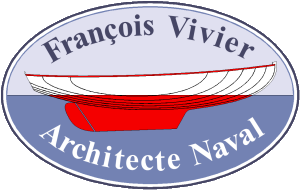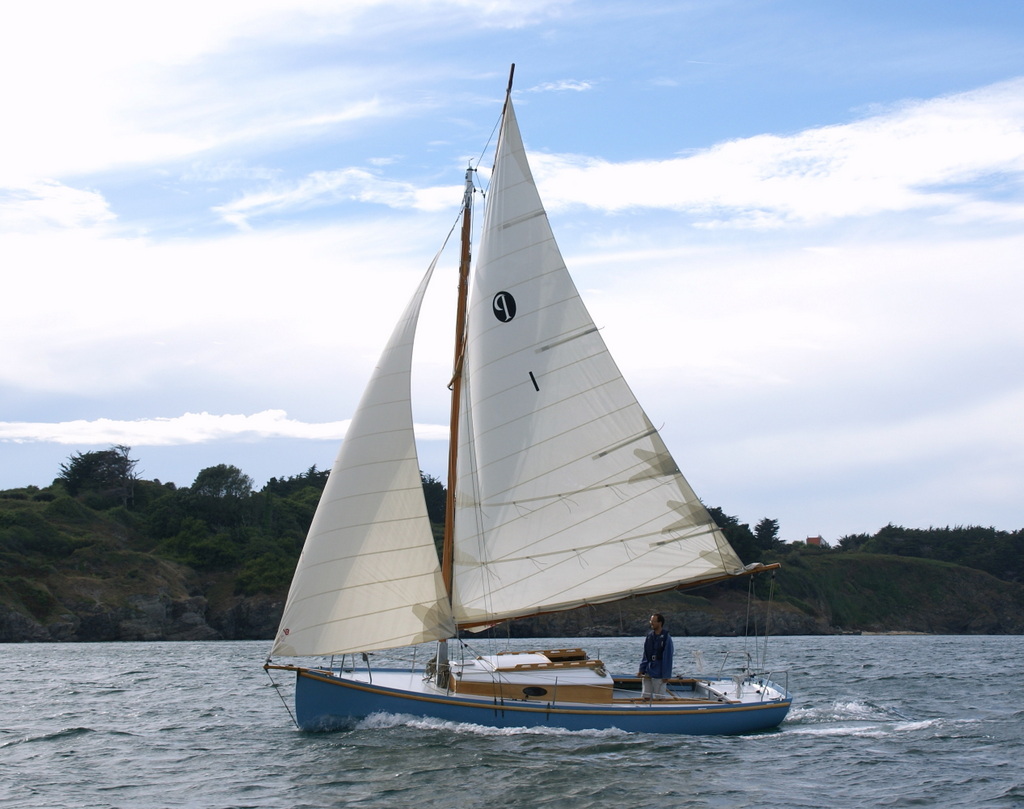- Study plans are extracts from the plans allowing the buyer to have a more precise knowledge of the plan content. If you are ordering the building plan, you do not need to order the study plan.
- The Building plan is the basic document to build the boat. It includes a free telephone or e-mail assistance.
- Attention: building this boat requires a numerically cut plywood kit.
- You may also buy the CNC cutting files allowing you sub-contracting the kit to a local company
- The kit is to be ordered from one of my partners.
- Postage and VAT, if applicable, are included in the shown prices.
Image already added
Traditionnal classic keel boat, 7.5 m long. The Architect boat!
| Hull length / waterline | 7.49 / 6.85 m | Sail area | 33.8 m² | ||
| Breadth / waterline | 2.50 / 2.07 m | Outboard motor | 10 hp | ||
| Draught | 1.15 m | Design category / Crew | B6 | ||
| Light weight / ballast | 1 850 / 600 kg | Building time with kit | 2 200 hours |
After many years on « sail and oars » boats, and some others on a raid boat (Stir-Ven), I wanted for my own use a keelboat able to sail the same coastal cruising I sailed when I was young. I also wanted to propose a new boat in my catalogue between the centreboarder Méaban and the 8.5 m Toulinguet. A boat big enough to allow a fortnight cruise. But I wanted it very easy to handle, even single-handed, and not requiring a diesel engine, an electric windlass and all those items now so common but which result in a large and expensive yacht. A small boat gives more pleasure and less trouble. Pen-Hir is the result of 4 years of thinking. Pen-Hir has the looks of traditional yachts of Brest and Carantec areas, with a plumbed stem and a short counter. She is gaff sloop rigged with a small bowsprit. I like the gaff sloop with a high peaked yard which is efficient and allows to step the mast in the tabernacle without external aid. A modern bermudian rig is also available on buyer’s request. The size of Pen-Hir, 7.5 m hull length, and its weight allow to trail it. She is fitted with two strong eyebolts enabling to handle the boat with a crane as for Dragon class boats. The accommodation is similar to Méaban but with more room, a larger galley and a semi-separated toilet. The mast is set on a strong but open bulkhead at the coachroof fore-end, thus non-obstructing access to the fore berth.
Around ten Pen-Hir have been built or are under construction in France, Germany, Switzerland, Belgium and the USA. Professional building by Grand-Largue boatyard in France which delivered a Pen-Hir in 2023 for Norway.
New version 2023
On the occurrence of a new order for a Pen-Hir at the Grand-Largue shipyard, I have modified the plans of the Pen-Hir to make the following main changes:
- Design category B instead of C, obtained by closing the space under the side deck of the cockpit and the motor well’s side spaces. The companionway threshold has been raised by 50 mm. Note that storing the beaching legs in a cockpit locker is possible. For those mainly aiming for coastal navigation in a tidal region, the beaching legs can be stored under the side deck of the cockpit, but then the boat remains in category C.
- The geometry of the engine well has been simplified with oblique sides. It is possible to fit an electric motor or a petrol outboard motor of 6 to 10 hp (only the 6 hp motor is tiltable).
- The sail plan is unchanged, but I have improved many rigging details, considering the experience of 12 years of navigation by the architect on his personal Pen-Hir. In particular, this facilitates single-handed navigation.
- Finally, the plans of the boat were modelled in 3D, which allowed a total overhaul of the construction manual. Appendix 4 presents more than 60 pages of 3D views of all the stages of the boat assembly.
The classic lateral plane.
All traditional yachts have a classic keel with the rudder attached at the aft. On modern boats, we always try to reduce the wet area and, therefore, to have a fin keel and a separated rudder. On Pen-Hir, I was very concerned about both performances and the ability to dry out on legs, which makes it possible to avoid calling in modern marinas. I made drag calculations showing that the number of appendages is a major factor. In other words, a classic keel-rudder is one appendage only, whereas many modern sailing boats have 3 (keel and 2 rudders). A classic keel also gives a more effective lateral resistance, particularly at slow speed, thus ideal for manoeuvring under sail in confined waters. Finally, the classic short keel, with the tiller at mid-cockpit and a well-canvassed rig, appears to be an excellent compromise for a boat requiring easy drying out. In addition, it dramatically reduces the risk of rudder damage. The draught may be modified at the owner’s request to cope with local mooring conditions. The NC cut plywood structure. Like many others of my designs, the structure of Pen-Hir is made of crisscrossed plywood bulkheads, including the vertical keel. This allows Icarai boatbuilder in Cherbourg (now closed) to have the boat ready for planking, including most of her accommodation parts, two weeks after receiving the NC cut plywood panels. The bottom planking is made of one single developed plywood panel. The bilge and sides are made of two cold moulded 6 mm plywood layers.
Sustainable development.
The boatbuilder and I have decided that the first Pen-Hir will be built respecting sustainable development as much as possible. We have launched a research and development program with several laboratories. We chose to exclude all tropical woods and, in particular, okume or mahogany plywood. The boat is made of first-class Finnish birch plywood, which is highly resistant and stiff. The only drawback is that birch, as okume, is not a durable wood. Therefore the hull and deck are epoxy sheathed, and all edges are properly protected. All main timber parts are made of oak, particularly the coachroof coamings. Pine is also used in the accommodations. The mast and spars are made of Douglas fir. Of course, Pen-Hir may also be built with okume marine plywood and redwood as timber, using specific CNC cutting files.
Electric propulsion.
In the same ecological spirit, I have decided to use electric propulsion. It is based on a 2 kW Torqeedo Cruise R outboard motor giving a thrust equivalent to a 6 hp petrol outboard. The remote throttle control is located in the cabin at helmsman’s hand. The motor is tilted in the aft well, so there is no speed loss when under sail. The batteries are located under the fore berths, allowing a range of about 20 nautical miles at 4 knots on a quiet sea. The motor is mainly intended for harbour access and manoeuvering but may also be used to return to shore if the wind falls. Batteries are charged from harbour electric power. The aft motor well may also receive a petrol outboard (up to 10 hp) at the owner’s choice.
Image already added


Francois Vivier –
You do not have to buy the CNC files if you buy a kit from one of my partners. They are required only if you find your own cutting company.
Jannie Carstens –
Dear Mr Vivier,
I note that you list the prices of printed plans & cnc cutting files , however there is a note that PEN-HIR can only be built with a cnc cut kit ?
Francois Vivier –
Sorry, but I have no idea of what is a Brazilian Guanabara. Do you have any picture?
Luiz Carlos Gertz –
Hello.
This boat is similar to the Brazilian Guanabara. Is there any relationship between these two boats? I’m looking for the original Guanabara.
Thank you for your attention
Eduardo de jong –
Hello, It looks like a Brazilian sailboat from the 50 tyes….Guanabara was her name and they use tô haver an iron você instead of a keel…please let me know what kind of ballast tou use in this model…..besta regards